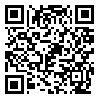year 6, Issue 1 (Semi-Annual 2022)
JIC 2022, 6(1): 57-70 |
Back to browse issues page
Download citation:
BibTeX | RIS | EndNote | Medlars | ProCite | Reference Manager | RefWorks
Send citation to:



BibTeX | RIS | EndNote | Medlars | ProCite | Reference Manager | RefWorks
Send citation to:
Rafiei Rad R, Mohamad zade M. Codification of the theory of fraction deduction, extracted from the life of Ibrahim (AS) in the Qur'an and explanation of its use and place in Islamic art, with the approach of data theory. JIC 2022; 6 (1) :57-70
URL: http://jih-tabriziau.ir/article-1-117-en.html
URL: http://jih-tabriziau.ir/article-1-117-en.html
1- Tabriz Islamic Art University
Abstract: (3722 Views)
Imitation and import of methods of producing works of art and the basics of art to Islamic civilization from other civilizations that rely on the theoretical foundations of those civilizations, in the contemporary era, has led to the mass production of works with different characteristics, and sometimes contradictory to the intellectual foundations of Islamic thought. The purpose of this study is to take the first steps to present a theory based on the Qur'an based on the way of thinking of Ibrahim (AS), which meets some of the functional and theoretical needs of artists in the Islamic world. Ibrahim (AS) in the Qur'an, as a historical figure, with five unique characteristics and overseeing his rationality and jurisprudence, such as intellectual development before prophecy, a good role model for believers, the possessor of insight, the possessor of a healthy and flawless heart and the observation of the kingdom of heaven and earth, has been introduced. Also, the opponents of his arguments, are idiots and fools. The question is, how can a theory based on the Abrahamic scientific way of thinking be constructed using the data-based approach? The present research is of qualitative type and has been done using Grounded theory method. After collecting all the data and performing open, pivotal and selective coding, while finding the answers, the mechanism of thinking of Ibrahim (AS) as a rational process, which creates new criteria based on the frequent critique of previous criteria, as the theory of "breaking idols" "It was expressed and its function in art was determined. Then the similarities and differences of this theory and critical thought that emerged in the context of subjectivism and the basis of modern art from Greenberg's point of view were introduced and the limits of human thought in Islamic thought were stated. Also, the absence of any discrepancy or contradiction of this theory with the principles, constants and unchangeable and eternal things that are necessary in the creation of traditional art, and in the heart of that religious art, was examined and determined. As a result, the mechanism of production and promotion of new criteria for creating new products based on successive criticisms in the context of the distance between servitude and lordship, was explained based on this theory. By dividing the world into the cognizant object and subject on the basis of the primacy of existence over nature, critical thought is allowed in the field of empirical science, relying on inductive reasoning, to critique the self-made criteria of the subject's mind indefinitely, thereby constructing new criteria. But in the theory of breaking idols, criticisms are made of the criteria in the human mind that move between servitude and lordship. This theory views man as the Caliph of God, who considers the infinite extent of the monotheistic world to be genuine, and at the same time, by building and breaking idols in the world of multiplicity, it prepares the ground for understanding the monotheistic world. It also provides a practical way to produce and critique existing works and past artistic values in conjunction with traditional art concepts.
Keywords: ", Ibrahim (AS) in the Quran", ", Islamic Art", ", Production of Artwork", ", Worship and Lordship", ", Critical Thinking"
Type of Study: Original Research |
Subject:
2
Received: 2020/10/20 | Accepted: 2022/01/12 | Published: 2022/11/23
Received: 2020/10/20 | Accepted: 2022/01/12 | Published: 2022/11/23
Send email to the article author
| Rights and permissions | |
 |
This work is licensed under a Creative Commons Attribution-NonCommercial 4.0 International License. |







 tabriziau.ac.ir
tabriziau.ac.ir